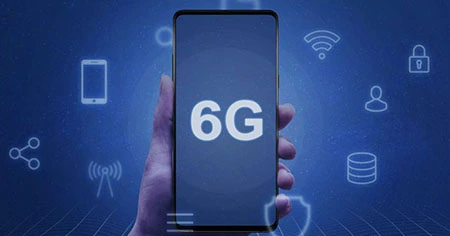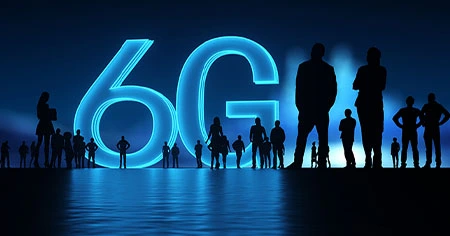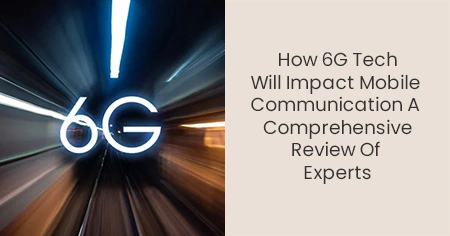Over the last four decades, mobile communication networks have undergone significant revolutionary development. While 5G technology opened the door to the Internet of Things, 6G aims to further advance this concept by evolving into a platform for "connected intelligence."
The 6G technology is expected to help mobile communication networks connect an array of smart devices, enabling real-time connectivity between the digital and physical worlds via machine learning and artificial intelligence (AI). It will also allow people to access and retrieve information in real-time, helping them enter an intelligent, connected world. As such, 6G will usher in the next era of digitalization.
The sixth-generation (6G) technology of mobile networks will set new standards to fulfill unreachable performance requirements by fifth-generation (5G) mobile networks. This is due to the high requirements for more intelligent networks, extreme network communication speed, ultra-low latency, and the ability to support many connected applications.
This article will discuss a Comprehensive review of Experts on how 6G Tech will impact mobile communication.
What is a 6G network?

A 6G network is a cellular network that operates on untapped radio frequencies and uses cognitive technologies such as AI to enable low-latency and high speed at a rate multiple times faster than fifth-generation networks. 6G networks are currently under research and development and are yet to be released.
According to research papers and telecommunications experts, 6G technology was initially meant for mobile phones, including transportation, agriculture, smart-home networks, and healthcare. In the process, ordinary people will experience seamless connectivity between everyday life and the Internet.
When will 6G be available to consumers?
6G technology is expected to be available around 2030. Most experts believe that new wireless communication standards emerge every decade or so. However, nothing is set in stone; even the term "6G" may fall out of favor and be replaced by something else.
Why is 6G technology Necessary?

The development of 6G technology arises from several factors and anticipated requirements in the ever-changing landscape of communication networks.
In addition to surpassing 5G, 6G will have unique features to establish next-generation wireless communication networks for linked devices via machine learning (ML) and artificial intelligence. This will also help emerging technologies like smart cities, self-driving cars, virtual and augmented reality, and smartphone and mobile network users.
It integrates and correlates various technologies, such as deep learning and big data analytics. A strong correlation between 6G and high-performance computing (HPC) has been discovered. While edge computing resources may process some IoT and mobile data, the vast majority will require much more centralized HPC capacity, making 6G an essential component.
Finally, developing 6G is a forward-looking approach to ensure that communication networks can keep up with changing technology trends and meet the demands of future applications that may require capacities, capabilities, and unprecedented speeds.
What do experts say about 6G?

According to VMware's Kaniz Mahdi, 6G research is still in its early stages. It will likely be another several years before 5G technologies like millimeter-wave achieve their full potential. The Open Grid Alliance aims to "re-architect" the Internet to support better major applications like automated vehicles and factory control systems.
"We are looking to evolve the internet itself," Mahdi said, mentioning that VMware is a member of the alliance.
As 6G research and technology progress, new challenges emerge. Dr. Mahyar Shirvanimoghaddam, an expert in wireless technology at the University of Sydney, told HighSpeedInternet.com in an email interview that environmental sustainability will be a major issue.
"6G is expected to provide the communication infrastructure for billions of devices." "These devices need to be constantly powered, and most will be battery-powered," he said. This manufacturing and energy consumption poses a potential environmental threat unless plans are made to reduce 6G technology's carbon footprint.
The 6G Flagship initiative combines research on 6G technologies across Europe. Japan is committing $482 million to expanding 6G in the coming years. The country aims to showcase cutting-edge wireless and mobile technologies by 2025. In Russia, the Skolkovo Institute of Science and the R&D institution NIIR and Technology issued a 2021 forecast predicting the availability of 6G networks by 2035.
American mobile providers are advancing their respective 6G innovation roadmaps. Verizon, AT&T, and T-Mobile notably drive the Next G Alliance, an industry initiative. In May 2021, the Next G Alliance launched a technical work program to develop 6G technology.
How will 6G technology impact mobile communications?

6G technology is expected to reduce the energy consumption of massive mobile wireless networks—green technologies and design principles to minimize the environmental impact of network infrastructure.
It aims to provide seamless connectivity for humans, machines, and devices, forming a pervasive network environment. The Integration of advanced technologies, such as edge computing, artificial intelligence, and advanced antenna technologies, can optimize network resource allocation, improve security, and enhance user experience.
Conclusion
6G aims to reduce the environmental impact of wireless networks while providing advanced connectivity. 6G is expected to use a different type of radio access network (D-RAN, C-RAN, and Open RAN), as well as novel frequency bands and spectrum resources to accommodate the increasing demand for wireless communication. As 6G technology continues to evolve, having a reliable internet provider is crucial for seamless connectivity. Cybernews has reviewed some of the best internet service providers, including an in-depth Xfinity internet review, to help you choose the best option for your needs.








